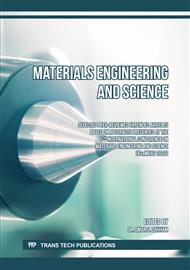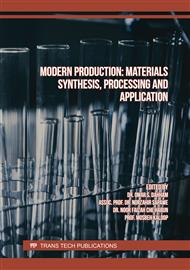[1]
D. Hull, T.W. Clyne, An Introduction to Composite Materials , third ed ,Cambridge University Press, (2019).
Google Scholar
[2]
Z. N. R. Alraziqi. Water Temperature Effect on Hardness and Flexural Strength of (PMMA/TiO2 NPs) for Dental Applications. Baghdad Science Journal, (2022) 0922-0922.
DOI: 10.21123/bsj.2022.19.4.0922
Google Scholar
[3]
H. A Sharhan, Z. N. Rasheed, J. K. Oleiwi, Synthesis and Physical Characterization of PMMA/PP and PMMA/PAN Composites for Denture Applications. Journal of Applied Sciences and Nanotechnology, 1(3), (2021) 13-23.
DOI: 10.53293/jasn.2021.3759.1040
Google Scholar
[4]
M. A. Tariq, Q. A .Hamad, M. K .Alwan ,Tensile and Buckling Analysis of the Polymer Composite Beam Reinforced by Natural Jute Fiber. Engineering and Technology Journal, 29, (2011) 129-140.
Google Scholar
[5]
K. L. Pickering, M. G. A. Efendy, and T. M. Le, A review of recent developments in natural fibre composites and their mechanical performance, Composites Part A: Applied Science and Manufacturing, vol. 83, (2016) 98–112.
DOI: 10.1016/j.compositesa.2015.08.038
Google Scholar
[6]
O. Bongomin, G. G. Ocen, E. N. Onyondi, A. Musinguzi, and T. Omara ,Exponential disruptive technologies and the required skills of industry , Journal of Engineering, , Article ID 4280156, (2020) 17.
DOI: 10.20944/preprints201910.0240.v2
Google Scholar
[7]
K. G. Satyanarayana, G. G. C. Arizaga, and F. Wypych, Biodegradable composites based on lignocellulosic fibers-an overview, Progress in Polymer Science, vol. 34, no. 9, (2009) 982–1021.
DOI: 10.1016/j.progpolymsci.2008.12.002
Google Scholar
[8]
W. N. Gilfillan, D. M. T. Nguyen, P. A. Sopade, and W. O. S. Doherty, Preparation and characterisation of composites from starch and sugar cane fiber, Industrial Crops and Products, vol. 40, 2012, p.45–54.
DOI: 10.1016/j.indcrop.2012.02.036
Google Scholar
[9]
E. Frollini and A. Castellan John Wiley & Sons, Hoboken, Phenolic resins and composites,, in Wiley Encyclopedia of Composites, , NJ, USA, 2nd edition, 2012 , p.2059–(2068).
DOI: 10.1002/9781118097298.weoc167
Google Scholar
[10]
E. Frollini, N. Bartolucci, L. Sisti, and A. Celli, Poly(butylene succinate) reinforced with different lignocellulosic fibers, Industrial Crops and Products, vol. 45, 2013,pp.160-169.
DOI: 10.1016/j.indcrop.2012.12.013
Google Scholar
[11]
B. Colbers, S. Cornelis, E. Geraets et al., A Feasibility Study on the Usage of Cattail (Typha spp.) for the Production of Insulation Materials and Bio-Adhesives, Wageningen University and Research Centre, Wageningen, Netherlands, (2017).
Google Scholar
[12]
A. Melkamu, M. B. Kahsay & A. G. Tesfay, Mechanical and water-absorption properties of sisal fiber (Agave sisalana)-reinforced polyester composite, Journal of Natural Fibers February (2018).
DOI: 10.1080/15440478.2018.1441088
Google Scholar
[13]
M. S. Teja, M. V .Ramana, D. Sriramulu and C. J. Rao, Experimental Investigation of Mechanical and Thermal properties of sisal fiber reinforced composite and effect of SiC filler material, Materials Science and Engineering, (2016) 149.
DOI: 10.1088/1757-899x/149/1/012095
Google Scholar
[14]
S. Kasiviswanathan, K. Santhanam, and A. Kumaravel, Evaluation of mechanical properties of natural hybrid fibers, reinforced polyester composite materials, Applied Science Innovations Pvt. Ltd. (2015) 43-49.
Google Scholar
[15]
S. Thomas and, L. Cellulose, fiber reinforced polymer composites. Philadelphia: Old City Publishing: (2008).
Google Scholar
[16]
Z.N. Azwa, B.F Yousif, A.C. Manalo and, W. Karunasena, A review on the degradability of polymeric composites based on natural fibres. Materials and Design, 47, 2013, pp.424-442.
DOI: 10.1016/j.matdes.2012.11.025
Google Scholar
[17]
E. A. Abdel-Rahim, H. S. El-Beltagi, & R. M. Romela, White Bean seeds and Pomegranate peel and fruit seeds as hypercholesterolemic and hypolipidemic agents in albino rats. grasas y aceites, 64(1), (2013) 50-58.
DOI: 10.3989/gya.095412
Google Scholar
[18]
Z. N. Rasheed, S. M. Hussein, Experimental study of food waste powder FWP influence on compressive and wear behaviour of polyester composite. In Journal of Physics: Conference Series, IOP Publishing, Vol.1795, No.1,(2021) 012037.
DOI: 10.1088/1742-6596/1795/1/012037
Google Scholar
[19]
R. A. Ibrahim. Tribological performance of polyester composites reinforced by agricultural wastes. Tribology International, 90, (2015) 463-466.
DOI: 10.1016/j.triboint.2015.04.042
Google Scholar
[20]
Z. N. Rasheed, S. M. Hussain, Impact strength behavior of PMMA denture base through addition of different nanoparticles after immersion in some nutrition liquids. Iraqi Journal of Physics, 17(41), (2019) 40-50.
DOI: 10.30723/ijp.v17i41.453
Google Scholar
[21]
A. Benyahia, A. Merrouche, Z. Rahmouni, M. Rokbi and Z. Kouadri, Study the Alkali Treatment Effect on the Mechanical Behavior of the Composite Unsaturated Polyester(UPE) _ Alfa Fiber, American journal of engineering research Vol.15, No 1 , 2014, PP.69_73.
DOI: 10.1051/meca/2013082
Google Scholar
[22]
ASTM-International, D790-00: Standard Test Methods for Flexural Properties of Unreinforced and Reinforced Plastics, Annual Book of ASTM Standards, (2000).
Google Scholar
[23]
F. H. Chowdhury, M. V. Hosur, and S. Jeelani, Investigations on the thermal and flexural properties of plain weave carbon/epoxy-nanoclay composites by hand-layup technique, Journal of materials science, vol. 42, no.8, 2007, p.2690–2700.
DOI: 10.1007/s10853-006-1370-3
Google Scholar
[24]
S. Swain, Synthesis and Characterisation of Graphene Based Unsaturated Polyester Resin Composites, Department of Advanced Material Process Technology Center, Crompton Greaves Ltd., Kanjur Marg, Mumbai, India. Transactions on Electrical and Electronics Materials Vol. 14, No. 2, 2013, p.53 – 58.
DOI: 10.4313/teem.2013.14.2.53
Google Scholar
[25]
N.Y. Mahmood, Studying the Effect of Mixture of Pomegranate Peel and Licorice on the Mechanical Properties of Epoxy ,Al-Nahrain Journal for Engineering Sciences, 2017, pp.871-875.
Google Scholar
[26]
A. Athijayamani, M. Thiruchitrambalam, V. Manikandan, B. Pazhanivel, Mechanical properties of natural fibers reinforced polyester hybrid composite, Central Institute of Plastics Engineering and Technology, (2009).
DOI: 10.1007/s12588-009-0016-0
Google Scholar
[27]
Q.A. Hamad, M. S. Abed, Invetigation of thyme and pumpkin nano pawders reinforced epoxy matrix composite, Journal of Mechanical Engineering Research and Developments (JMERD) 42(5), (2019)153-157.
DOI: 10.26480/jmerd.05.2019.153.157
Google Scholar
[28]
Q. A, Hamad, L. A. Khalaf, M. S. Abed, M. N. AlShroofy," The Adding Influence of Natural Nano Powder to Unsaturated Polyester as a Green Composite for Prosthetic Socket Application, AIP Conference Proceedings, (2021).
DOI: 10.1063/5.0070680
Google Scholar
[29]
J. Sarki, S.B. Hassan, V.S. Aigbodion, J.E. Oghenevweta, Potential of using coconut shell particle fillers in eco-composite materials,, Journal of Aand Compounds, (2010).
DOI: 10.1016/j.jallcom.2010.11.025
Google Scholar
[30]
Q. A, Hamad, M. N. Al-Shroofy And M. S. Abed, Utilization of Palm Seeds Nano powder Reinforced Polyester as a Green Composite, Journal of Mechanical Engineering Research and Developments, Vol. 44, No. 1, 2021, pp.242-253.
Google Scholar
[31]
J. K.Oleiwi, Q.A. Hamad , Studying the Mechanical Properties of Denture Base Materials Fabricated from Polymer Composite Material,, Al-Khwarizmi Engineering Journal,Vol.14, 2018, P.P.100.
DOI: 10.22153/kej.2018.01.006
Google Scholar
[32]
R. Kaunda, A. Patnaik, A. Satapathy, Solis Particle Erosion of short Glass Fiber Reinforced Polyester Composite, American Journal of Materials Science (2012).
DOI: 10.5923/j.materials.20120202.05
Google Scholar
[33]
S. Thomas, K. Joseph, S.K. Malhorta, K.Goda and M.S. Sreeka ,PolymerComposites, Wiley-VCHVerlag Gmb H&Co. KGaA, Volume 1. (2012).
Google Scholar
[34]
R.O. Akaluzia, F.O. Edoziuno, A.A. Adediran, B.U. Odoni, S. Edibo, T.M.A. Olayanju, Evaluation of the effect of reinforcement particle sizes on the impact and hardness properties of hardwood charcoal particulate-polyester resin composites',, Materials Today, (2020)570-577.
DOI: 10.1016/j.matpr.2020.02.980
Google Scholar
[35]
H.A. Sharhan, Z.N. Rasheed, and J. K. Oleiwi, Effect of Polypropylene (PP) and Polyacrylonitrile (PAN) Fibers Reinforced Acrylic Resin on Compression, Hardness and Surface-Roughness for Denture Applications, Key Engineering Materials. Vol. 911. Trans Tech Publications Ltd, 2022.
DOI: 10.4028/p-197rys
Google Scholar



